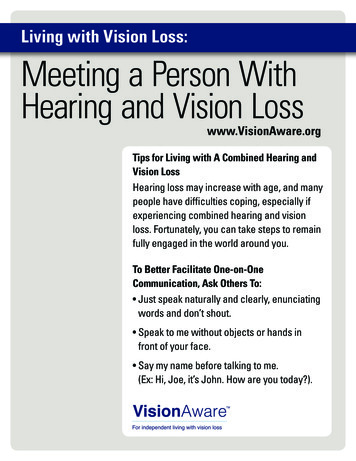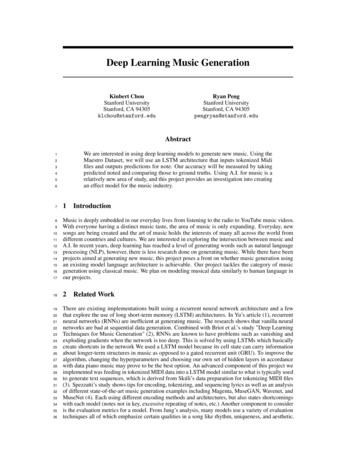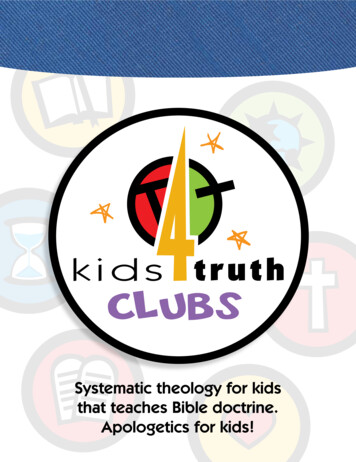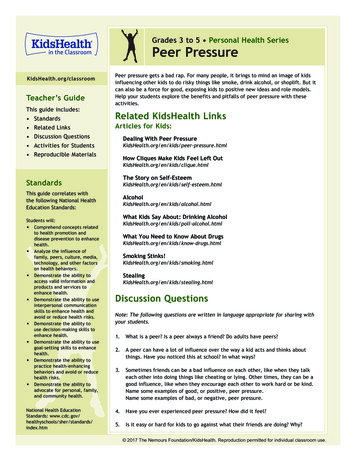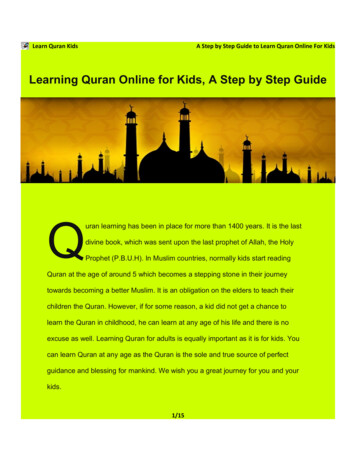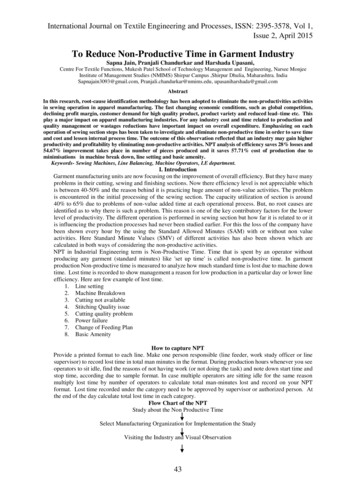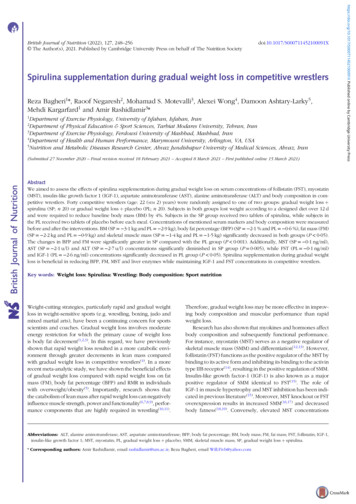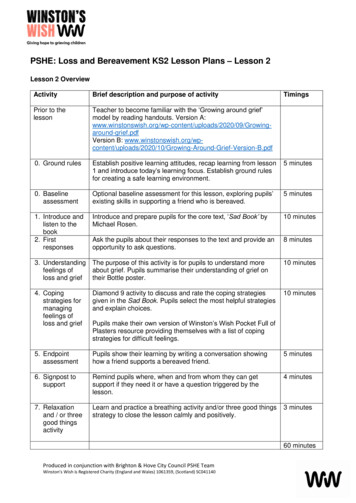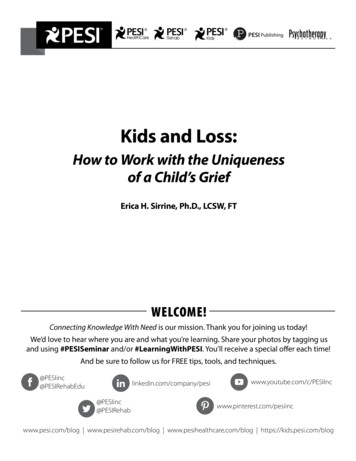
Transcription
RehabKidsKids and Loss:How to Work with the Uniquenessof a Child’s GriefErica H. Sirrine, Ph.D., LCSW, FTWELCOME!Connecting Knowledge With Need is our mission. Thank you for joining us today!We’d love to hear where you are and what you’re learning. Share your photos by tagging usand using #PESISeminar and/or #LearningWithPESI. You’ll receive a special offer each time!And be sure to follow us for FREE tips, tools, and www.pinterest.com/pesiincwww.pesi.com/blog www.pesirehab.com/blog www.pesihealthcare.com/blog https://kids.pesi.com/blog
Kids and Loss:How to Work with the Uniquenessof a Child’s GriefErica H. Sirrine, Ph.D., LCSW, FTRehabKidsZNM0579954/21
Copyright 2021PESI, Inc.PO Box 10003839 White Ave.Eau Claire, Wisconsin 54702Printed in the United StatesPESI, Inc. strives to obtain knowledgeable authors and faculty for its publications andseminars. The clinical recommendations contained herein are the result of extensiveauthor research and review. Obviously, any recommendations for client care must beheld up against individual circumstances at hand. To the best of our knowledge anyrecommendations included by the author reflect currently accepted practice. However,these recommendations cannot be considered universal and complete. The authorsand publisher repudiate any responsibility for unfavorable effects that result frominformation, recommendations, undetected omissions or errors. Professionals usingthis publication should research other original sources of authority as well.All members of the PESI, Inc. CME Planning Committee have provided disclosure offinancial relationships with commercial interests prior to planning content of thisactivity. None of the committee members had relationships to reportPESI, Inc. offers continuing education programs and products under thebrand names PESI HealthCare, PESI Rehab, PESI Kids, PESI Publishing andPsychotherapy Networker. For questions or to place an order, please visit: www.pesi.com or call our customer service department at: (800) 844-8260.14pp4/21RehabKids
Materials Provided ByErica H. Sirrine, Ph.D., LCSW, FT, is a licensed clinical socialworker, qualified clinical supervisor and the dean of the Schoolof Social Work at Southeastern University. She has over 17 yearsof experience in the field of death, dying and bereavement andhas been awarded the distinction of Fellow in Thanatology bythe Association for Death Education and Counseling. She hasconducted and published research on the continuing bondsmaintained by survivors following a death, and she recentlyauthored and published Sammy’s Story, an anticipatory griefcounseling book for young children experiencing the seriousillness of a loved one.Dr. Sirrine has extensive expertise providing individual andgroup therapy to bereaved children, adolescents, adults andfamilies. She has implemented numerous interventions andprograms aimed at improving the emotional health of clientsexperiencing loss. Dr. Sirrine presents seminars on bereavementand loss throughout the United States and is known for herinteractive and engaging workshops. She has been distinguishedas “Professor of the Year” and the National Association of SocialWorkers Heartland, Florida Unit’s “Social Worker of the Year.”Speaker Disclosure:Financial: Erica Sirrine receives compensation as an Associate Professor at SoutheasternUniversity. She receives a speaking honorarium from PESI, Inc.Non-financial: Erica Sirrine is a member of the National Association of Social Workers, TheAssociation of Baccalaureate Program Directors, the National Alliance for Grieving Children, andthe Florida Association of Deans and Directors. She does not receive compensation.Materials that are included in this course may include interventions and modalities that are beyond theauthorized practice of mental health professionals. As a licensed professional, you are responsible forreviewing the scope of practice, including activities that are defined in law as beyond the boundaries ofpractice in accordance with and in compliance with your professions standards.
Grief Summit 2021:Supporting Grieving Children &AdolescentsDr. Erica Sirrine, Ph.D., LCSW, FTwww.hopeandgrief.com1APA DisclosureMaterials that are included in this course may include interventions and modalities that are beyond theauthorized practice of mental health professionals. As a licensed professional, you are responsible for reviewingthe scope of practice, including activities that are defined in law as beyond the boundaries of practice inaccordance with and in compliance with your professions standards.21
Parental andSibling LossChildhood Bereavement Estimation Modeljudishouse.org3Childhood BereavementResources National Alliance for Grieving Children https://childrengrieve.org Dougy Center- The National Center for Grieving Children and Families https://www.dougy.org Judi’s House/JAG Institute https://judishouse.org42
Non-Death Losses and Children Divorce Military Deployment Parental Separation Peer Group/Friendship Changes Parental Incarceration Social Status Changes Adoption School Change Foster Care/Termination of ParentalRights Parental Unemployment Illness Move/Relocation Parental Substance Use/Mental Illness5Grief vs. MourningA Distinction Grief “Deep sorrow” Mourning “The (outward) expression of deep sorrow” “The act of sorrowing”63
“Getting Over It”vs.Reconciliation7Core Tenets and Principles ofGrief-Informed PracticeDougy Center (Schuurman & Mitchell, 2020) Natural Personal Empowerment & Agency Nonpathological & Complex Safety Contextual Person-Centered Disruptive Dynamic Relational Connection & PerceivedSupport Non-Finite84
DistinctionsBetween Adult and Youth Responses to Loss “Forgotten Mourners” Impacted by Cognitive Development Impacted by Adults (and how those adults allow or avoid emotions) Use of Play to Cope (Actions vs. Words)- “Decoding” Behavior Peer Relationships/Social Status Changes9Cognitive ComponentsOf Understanding Death in Childhood Universality Irreversibility Nonfunctionality Causality105
Grief Emotions11Common Grief Reactions Regressive Behaviors Guilt/Regret Magical Thinking Fear/Anxiety Disbelief/Confusion Faith/Spirituality Questions Difficulty Concentrating Isolation/Loneliness Change in school work/grades “Grief Bursts” Sadness/Depression Physical Symptoms (tummy/headaches,etc.) Mood Changes Sleep Problems/Disturbances Anger/Protest Lethargy/Fatigue Acting out/Aggressive behavior Continuing Bonds/Mystical Experiences126
“Things We Want Adults toKnow about our Grief”13School-Based and SupportGroup BereavementInterventions147
Considerations for School-Based Counseling Parental Permission Relationships with Constituents Maintaining Confidentiality Counseling location, student comfort level, staff questions- Case Example: “High School” Parental Communication and Follow-Up15Support Group Considerations Structure Open vs. Closed Duration/Frequency of Meetings Facilitators- Therapists vs. Trained Peer Volunteers Number of Participants Adult, Youth, or Youth and Parent/Caregiver Pre-Screening168
Family Bereavement ProgramEvidence-Based, Family Support Group Intervention Developed for parentally-bereaved youth and caregivers (Ayers et al., Sandler et al.). Focuses on reducing risk factors and strengthening protective factors Youth and Caregiver Program Child (ages 8-12) Adolescent (ages 12-16) 12 group sessions (2 hours each) Focuses on psychoeducation, coping, and caregiver skills Training manuals available for youth and caregiver groups (Ayers et al.)17Pathfinders Program- Judi’s HouseNewly Developed (Evidence-Informed) Developed at Judi’s House (Griese, Burns, & Farro, 2018) Combines elements of evidence based treatments including the FBP, TF-CBT, and GTI with peergrief support group approaches Acknowledges that grief is uniquely experienced by each person Avoids minimizing or pathologizing Strengths-based Focuses on “decreasing disruptive grief reactions” while “increasing restorative griefexperiences” 10 sessions (three phases), 50-90 minutes in length Three curricula- Children (3-11 years), Adolescents (12-18 years), Adults189
General Grief Support GroupWeekly Session Topic Outline My Loss Story (Death/Grief Narrative) Coping With and Expressing Feelings of Loss (Anger) Seeking Support after Loss Coping with Changes Caused by the Loss (Good and Bad Changes) Self Care following Loss Remembering the Loss/Sharing Memories (Positive and Negative) Honoring the Loss/Memorializing (Continuing Bonds) Final Group/Meal Sharing/Strengths-Based192010
“If ever there is a tomorrow when we're nottogether. there is something you mustalways remember. You are braver than youbelieve, stronger than you seem, andsmarter than you think. But the mostimportant thing is, even if we're apart.I'llalways be with you.”- Winnie the Pooh21Questions?erica@hopeandgrief.com2211
Online Resources www.bosplace.org http://childrengrieve.org/ www.dougy.org https://judishouse.org /2312
Grief Summit 2021- ReferencesErica SirrineSupporting Grieving Children and AdolescentsReferencesAyers, T. S., Sandler, I. N., Lutzke, J. R., Twohey, J. L., Li, S., Losoya, S., et al. (1996). Familybereavement program: Group leader intervention manual for adolescentprogram. (Available from Prevention Research Center, Arizona State University, 900S. McAllister Ave. Room 205, P.O. Box 876005, Tempe, AZ 85287-6005.)Ayers, T. S., Wolchik, S. A., Weiss, L., Sandler, I. N., Jones, S., Cole, E., et al. (1996).Family bereavement program: Group leader intervention manual for parentprogram. (Available from Prevention Research Center, Arizona State University, 900S. McAllister Ave. Room 205, P.O. Box 876005, Tempe, AZ 85287-6005.)Ayers, T. S., Wolchik, S. A., Sandler, I.N., Twohey, J. L., Weyer, J. L., Padgett-Jones, S., et al.(2014). The family bereavement program: Description of a theory-based prevention programfor parentally-bereaved children and adolescents. Omega, 68, 293–314. doi:http://dx.doi.org/10.2190/OM.68.4.aBurns, M., Griese, B., King, S., Talmi, A. (2020). Childhood bereavement: Understandingprevalence and related adversity in the United States. American Journal of Orthopsychiatry.Advanced online publication.Chen, C.Y., & Panebianco, A. (2018). Interventions for young bereaved children: A systematicreview and implication for school mental health providers. Child and Youth Care Forum, 47(2), 151-171. doi: 10.1007/s10566-017-9426-xDeSpelder, L. A., & Strickland, A. L. (2020). The last dance: Encountering death and dying(11th ed.). New York: McGraw-Hill.Ener, L., & Ray, D.C. (2018). Exploring characteristics of children presenting to counseling forgrief and loss. Journal of Child and Family studies, 27 (3), 860-871. doi: 10.1007/s10826017-0939-6Griese, B., Burns, M., & Farro, S. A. (2018). Pathfinders: Promoting healthy adjustment inbereaved children and families. Death Studies, 42 (3), 134-142. doi:10.1080/07481187.2017.137041613
Merriam-Webster Online Dictionary (2015). Retrieved June 5, 2015 from http://www.merriamwebster.com/Judi’s House (2020). Childhood Bereavement Estimation Model. Retrieved fromwww.judishouse.org/CBEM.Sandler, I. Tein, J.Y., Wolchik, S., & Ayers, T.S. (2016). The effects of the familybereavementprogram to reduce suicide ideation and/or attempts of parentally bereaved children six andfifteen years later. Suicide and Life-Threatening Behavior, 46 (1), S32-38. doi:10.1111/sltb.12256Schuurman, D. L., & Mitchell, M. B. (2020). Becoming grief-informed: A call to action. DougyCenter: National Grief Center for Children & Families. www.dougy.orgStroebe, M., Schut, H., & Boerner, K. (2017). Cautioning healthcare professionals: Bereavedpersons are misguided through the stages of grief. OMEGA: Journal of Death and Dying, 74(4), 455-473. doi: 10.1177/0030222817691870Wolfelt, A. (2003). Understanding your grief: Ten essential touchstones for finding hope andhealing in your heart . Fort Collins, CO: Companion Press.14
NOTES
NOTES
authored and published Sammy’s Story, an anticipatory grief counseling book for young children experiencing the serious illness of a loved one. Dr. Sirrine has extensive expertise providing individual and group therapy to bereaved children, adolescents, adults and families. She ha

